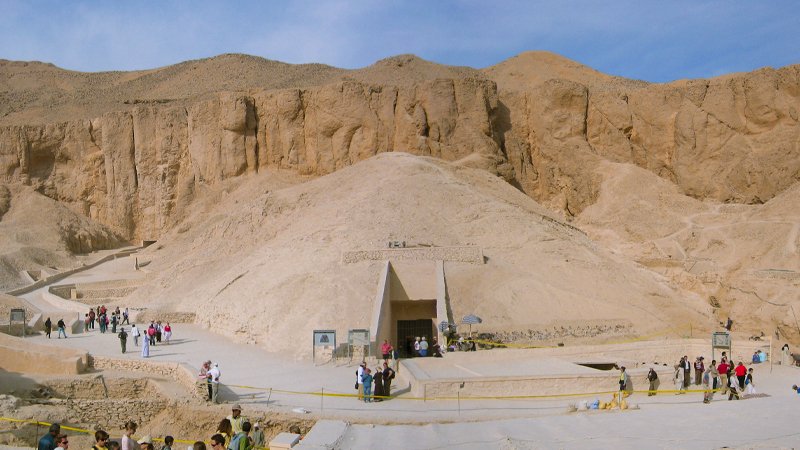Nestled on the west bank of the Nile River near Luxor, the Valley of the Kings is one of Egypt’s most iconic and historically significant sites. This ancient burial ground, which served as the final resting place for Pharaohs and nobles of the New Kingdom (16th to 11th century BCE), offers an unparalleled glimpse into Egypt’s rich Pharaonic history. For travelers fascinated by Egypt’s ancient civilization, a visit to the Valley of the Kings is essential. This vast necropolis, with its beautifully adorned tombs, continues to captivate visitors from all over the world, providing a window into the grandeur and beliefs of ancient Egyptian royalty.
Historical Significance of the Valley of the Kings
The Valley of the Kings holds a unique place in ancient Egyptian history. It was established during the Eighteenth Dynasty when pharaohs sought secluded and secure burial sites away from the grand pyramids of earlier dynasties.
The valley’s isolated location helped deter grave robbers, and its tombs were designed to protect both the physical remains of the kings and their journey into the afterlife. Some of Egypt’s most famous rulers, including Ramses II, Seti I, and Tutankhamun, were buried here, each in tombs elaborately decorated with scenes of their divine journey to the afterlife. These tombs were carved deep into the mountains, and the vivid artwork and hieroglyphs provide valuable insight into the religious beliefs and funerary practices of the time.
The Discovery of King Tutankhamun’s Tomb
Perhaps the most famous discovery in the Valley of the Kings was that of King Tutankhamun’s tomb in 1922 by British archaeologist Howard Carter. Tutankhamun, often referred to as the “Boy King,” ruled during the Eighteenth Dynasty and became a global sensation due to the incredible wealth of treasures found in his tomb.
Unlike many other tombs that were plundered by grave robbers, Tutankhamun’s tomb remained largely intact, offering a wealth of artifacts, including his golden death mask, jewelry, and even his chariot. This discovery shed light on the wealth and opulence of the Egyptian Pharaohs and sparked a renewed interest in Egyptology, drawing millions of visitors to the Valley of the Kings each year.
The Architecture and Design of the Tombs
The tombs of the Valley of the Kings are architectural marvels, designed to house the remains of the Pharaohs as well as ensure their safe passage to the afterlife. Each tomb was meticulously planned and decorated according to the king’s status and the religious beliefs of the time.
The tombs are typically composed of long corridors leading to a burial chamber, with walls adorned with hieroglyphs, vibrant paintings, and scenes depicting the king’s journey through the underworld. The artwork inside the tombs reveals much about the ancient Egyptians’ beliefs in the afterlife, as well as the deities and rituals they revered. The tombs of Ramses II, Seti I, and Tutankhamun stand out for their impressive scale and the intricate detail of their carvings.
Religious Beliefs and Funerary Practices
The Valley of the Kings wasn’t just a burial ground; it was a sacred place where the Pharaohs’ bodies would undergo the necessary rituals for their journey to the afterlife. Ancient Egyptians believed that life after death was a continuation of earthly existence, but only if the body was preserved and the proper rites were performed.
The valley was chosen for its symbolic connection to the setting sun, which represented the Pharaoh’s passage from life to the afterlife. Elaborate funerary rituals, including mummification, were carried out to preserve the king’s body. Tombs were filled with treasures, food, and even servants (represented in statues) to serve the Pharaoh in the afterlife. This connection between religion, death, and eternal life is vividly illustrated on the tomb walls in the valley.
How to Visit the Valley of the Kings
For modern travelers, a visit to the Valley of the Kings is a journey back in time. Located near the city of Luxor, the valley is easily accessible by road, and most visitors begin their exploration in Luxor, where they can also visit other important historical sites such as Karnak Temple and Luxor Temple.
The best time to visit is during the cooler months, from October to April, when temperatures are more manageable for exploring the desert landscape. Visitors should plan for a full day to explore the valley, as there are over 60 tombs, many of which are open to the public. Tickets are required to enter the site, and there are additional fees to enter specific tombs, including Tutankhamun’s.
Key Tombs to Visit in the Valley of the Kings
While the Valley of the Kings contains over 60 tombs, only a select few are open to the public at any given time. Some of the most significant tombs that travelers should prioritize include:
Tomb of Tutankhamun (KV62): The most famous tomb in the valley, this is where Howard Carter discovered the boy king’s treasures. While most of the artifacts have been moved to museums, the tomb still houses Tutankhamun’s mummy.
Tomb of Ramses VI (KV9): Known for its beautifully preserved paintings and intricate ceiling decorations, this tomb offers a stunning depiction of the afterlife.
Tomb of Seti I (KV17): One of the largest and most elaborately decorated tombs in the valley, Seti I’s tomb is a masterpiece of ancient Egyptian art and architecture.
Exploring these tombs provides visitors with a deeper understanding of ancient Egypt’s grandeur and its obsession with the afterlife.
The Preservation Efforts of the Valley of the Kings
Over the centuries, the tombs of the Valley of the Kings have faced significant threats from both natural forces and human activity. Flooding, erosion, and vandalism have all taken their toll on the fragile structures. In recent decades, the Egyptian government, alongside international organizations, has worked tirelessly to preserve and protect the tombs for future generations.
Advanced technologies such as 3D scanning and conservation techniques have been employed to safeguard the tombs’ artwork and structure. Visitors today are encouraged to respect these efforts by following strict guidelines, including limiting photography and ensuring the tombs are not damaged during visits.
The Valley of the Kings and Modern Archaeology
The Valley of the Kings continues to be an active archaeological site, with ongoing excavations and discoveries adding to our understanding of ancient Egypt. Archaeologists are still uncovering new tombs, artifacts, and insights into the lives of the Pharaohs and their people. Modern technology, such as ground-penetrating radar and DNA analysis, has allowed researchers to explore the valley in ways that were not possible before. These discoveries help to paint a more complete picture of ancient Egyptian society, its rulers, and the complex belief systems that shaped their world.
Planning Your Trip: Tips for Travelers
When planning a trip to the Valley of the Kings, it’s important to be well-prepared to make the most of your visit. Here are some essential tips:
Arrive early: The Valley of the Kings can get crowded, especially during peak tourist seasons. Arriving early in the morning will allow you to explore the tombs in relative peace.
Dress appropriately: The valley is located in the desert, so be prepared for hot and sunny conditions. Wear light, breathable clothing, a hat, and plenty of sunscreen. Comfortable shoes are also essential for walking through the site.
Hire a guide: To fully appreciate the history and significance of the Valley of the Kings, consider hiring a knowledgeable guide. Many guides are well-versed in the history of the tombs and can offer insights that you might miss on your own.
By planning ahead, visitors can ensure a smooth and enriching experience as they explore one of the most remarkable archaeological sites in the world.
Conclusion: A Journey Through Time
A visit to the Valley of the Kings is a journey through time, offering travelers the chance to step into the world of the ancient Pharaohs and experience firsthand the grandeur of ancient Egyptian civilization. From the breathtaking tombs of legendary rulers like Ramses II and Tutankhamun to the stunning artwork and religious symbolism that adorn their resting places, the Valley of the Kings is an unmissable destination for anyone seeking to understand Egypt’s rich history.
As a site that continues to reveal its secrets through ongoing archaeological work, it remains a powerful testament to the skill, artistry, and beliefs of the ancient Egyptians. For travelers to Egypt, the Valley of the Kings is not just a stop on an itinerary—it’s a gateway to understanding the wonders of the ancient world.

